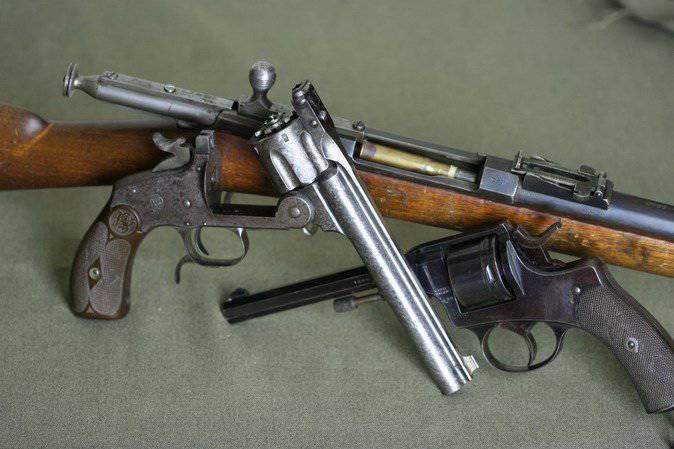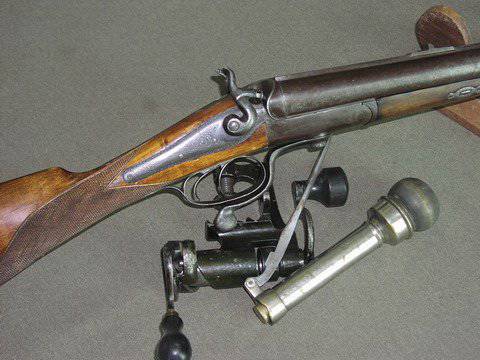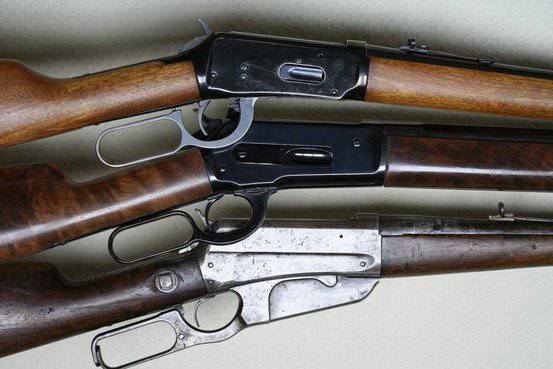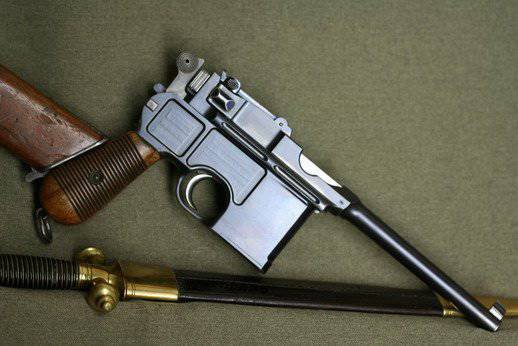Weapons for hunting and self-defense of Russians in the Far East and Manchuria at the turn of the 19-20 centuries.

Russian Far East, wild, wild Ost ... The harsh climate, inexhaustible natural wealth, incredible distances, unexplored indigenous people, sometimes overshadowing American Indians with their belligerence ... Mastering Siberia and the Far East is a grandiose epic, our honor, pride and glory! It was a long time ago, but still at the end of the 19 century, the life of a small Russian population in these parts was uneasy and everyday dangerous. These factors, as well as the proximity of America and China, together with the peculiarities of the animal world and the isolation of marginal lands from the European part of Russia, left their imprint on the arming of the population of the region.
Those who went to meet the unknown, mastered these lands in the name of Russia, died from scurvy, fever, cold and arrows of the natives ... Poyarkov, Khabarov, Shelikhov, Baranov, Rezanov ... and many, many others - these people were true statesmen, disinterested sons of Russia , unfortunately, almost forgotten today by ungrateful descendants.
The development of Siberia and the Far East is a daunting task, brilliantly solved by a whole galaxy of military and traveling scientists of the Russian Empire. One of these outstanding enthusiasts, the real son of his time, was Vyacheslav Panteleimonovich Vradiy.
Born in 1871 in Petersburg, at a very young age, Vradiy became a famous zoologist, enthusiastically engaged in ethnography, traveled a lot, and later published and edited the journal Siberian Thought. Vyacheslav Panteleimonovich did a lot for the Amur Regional Museum of Local Lore. G.S. Novikov-Daursky, existing from 16 in August 1891. In 1904, Vradiy published his “Information, facts and conclusions from a two-year trip to Asia”, notable for its reflection of the life of the Russian population in the Far East. Of course, we are more interested in issues related to firearms. weapons and the specifics of its use, set out by scientists in their work.
Leaving St. Petersburg to the Far East and planning to engage in scientific research in the field of zoology, ethnography, etc., Vyacheslav Panteleimonovich also set himself the aim of obtaining an exhaustive answer to the following question: what kind of weapon for hunting and self-defense should a scientist stock up on? countries? The question was far from idle - do not forget that in those days, a researcher who studied ethnography and the nature of new marginal lands, risked his life in earnest, and if he wanted to live, he had to have a good weapon.

Had become accustomed to mid-band and northern Russian hunts, Vradiy took a shotgun with him, and for self-defense - a large-caliber 5 revolver. A quite sensible combination, however, barely stepping on the soil of Asia, Vyacheslav realized that "not such a weapon can be of paramount importance, in terms of practicality and applicability to the conditions of this area." Leaving Vladivostok to Manchuria, a distant and unknown at that time, the traveler consulted with the builders of the East China Railway, making inquiries at the gun stores of the city. As it turned out, the shotgun, according to Vradia, “can serve here, in the vicinity of Vladivostok and in the taiga of Manchuria, only, most likely, as fun, but not as a serious gun. A shotgun, of course, does not interfere with stocking up, but precisely as an additional weapon, and not the main one, like in our central or northern strip of Russia ... ”

In Vladivostok, gun shops offered Wradia hard drives (then in the Russian Far East and in the world, mainly models of the 1892 and 1894 patterns), Mauser’s German rifles and even the “Mauser’s notorious gun-gun” (obviously, we are talking about 96). Most merchants praised the "German small-caliber rifle." Probably, here we are talking about the "commission" Mauser arr. 1888 of the year.
In Smith's American shop selling American weapons in Vladivostok (and canned food, by the way), the Russian scientist was strongly “advised to stock up on eight or ten-charging hard drives.” Vradiy noted that the majority of Russians in Vladivostok and the Ussuri railway line, which have at least some concept of hunting, are used specifically by hard drives. For here, in the Ussuri region, where you can stumble upon a tiger, on a red "evil wolf", finally, on a "good-natured Ussuri bear with a white collar" - you should always be ready and have a shotgun, not a shotgun.
Analyzing the armament of the Russian inhabitants of Vladivostok, Vradiy writes that their weapons are not found very often (with the exception of a revolver). But, if it is available - it will be a medium-caliber hard drive, which is extremely popular among locals. As for the residents of the environs of Vladivostok and the Russian settlers who live in “different dungeons and manors”, they will, at the first opportunity, have a hard drive - both for hunting large animals or sea birds, and for self-defense.
Reasonably following the collective experience, Vradiy in Vladivostok got a ten-drive hard drive, which was really very useful during a long expedition. The first use of a new thing a scientist made in the sandy shallows of Sungouri, which then were completely covered with countless flocks of geese. As it turned out, korotkoboynaya rapid-fire rifle is great for hunting large birds. Not less, this weapon was useful to the traveler during exchanges of fire with "wild Manchus". As Vradiy writes, “this gun is convenient in the sense of a rate of fire for an emergency shootout.” On the way to Manchuria, Vradiy discovered that private steamboats making river flights between Khabarovsk and Manchuria along the Sungari River were armed by the Russian Government "with an entire arsenal of military guns of our new model, which are an enviable goal of many Russians and foreigners who always want to have a Russian rifle personally for myself". Visiting the cabin of the steamer captain, Vyacheslav Panteleimonovich saw a large number of Mosin three-line rifles fixed in rows along the wall in special racks. The captain willingly told the traveler that these rifles are an excellent means for countering the Manchus, who often fire Russian steamers from the shore. In addition to the hard drives, the "three-line" was also valued among the employees of the Chinese railway. In one hunter, the head of one of the posts on the uninhabited bank of Sungari, the traveler saw an unusual weapon for him - “a double-barreled shotgun, one of the barrels of which was a“ choke ”, and under these two trunks, i.e. - at the bottom, between them, there is a barrel for bullet firing - a threaded nozzle. ” According to Vradia, “the hunters found this triple-barreled gun, i.e. shotgun, in conjunction with a choke, extremely practical for Manchu hunts. Noting that such a gun can cost several hundred rubles, Vyacheslav Panteleimonovich finds this weapon ideal for an amateur hunter who is used to shooting mainly marsh game and only occasionally encountering a large and dangerous beast. However, the ideal is an ideal, but Vradiy rightly notes that "such guns are good, of course, only expensive samples ...". Well, since then nothing has changed: and nowadays good drilling is an expensive pleasure. In a couple of years of his Asian journey, VP Vradiy became an experienced hunter, moreover, he was able to stand up for himself and in direct confrontation with unsuited thugs. The experience of active scientific work in a troubled region has allowed to form the answer to the desired question - about the most practical weapon for a traveler in Asia. In the words of Vradia himself, “if we consider which most utilitarian gun is suitable, in general, for the whole Far East, then we will have to say that if it is one gun, then you need to take with you only a hard drive or a rapid-fire gun (magazine rifle. Appro. .M.), Or, finally, the Mauzer pistol; This latter can be recommended for a middle-income hunter. ”

According to the testimony of Vradiya, the medium-caliber hard drive in Vladivostok was then worth about 40-60 rubles. and more expensive. Sometimes it was possible to buy a good hard drive from second-hand rubles for 15-25. Then, as an addition to it, Vradiy recommends either an ordinary 20-16 shotgun of a caliber or a smooth-bore “fighter”, which was then popular throughout Russia. Regarding the three-barrel rifle with one rifled barrel, our scientist recommends it to rich hunters. In addition, he points out his shortcomings: a large mass and low usability for self-defense due to the low rate of fire (compared to hard drives and combat magazine rifles).
For everyday excursions in the vicinity of Harbin and other Manchu cities (ordinary walks, not for hunting purposes), Vradii strongly recommends that you always have a reliable medium-caliber revolver, suitable for hidden carrying in your pocket. In the extreme case, in the absence of a compact revolver, Army Nagant is also quite acceptable for such tasks. Apparently, the reasons for such recommendations from the Russian ethnographer were very compelling ... Already returning to St. Petersburg and analyzing the results of his journey, Vyacheslav Panteleimonovich came to the final conclusion: “an ordinary hunter and, at the same time, a tourist who could put his life in danger of Far East (in peacetime), should have in his and in Manchuria three kinds of weapons. These are: firstly (by all means!) - a winchester or a military gun (the latter is better), secondly - an ordinary central combat shotgun or smoothbore rifle (the second is more convenient for small hunts) and, thirdly, an average American -or revolver, which can be imperceptibly worn with him, so that he would not be constrained during long or short walks. And one more piece of advice: for each of these weapons, you must have a reserve of pre-prepared and serviceable cartridges, because in Manchuria there are places where cartridges have to be stocked up for almost a whole year ahead ... ”Well, and today, more than centuries ago are more than relevant, even if we abstract from their purely conceptual aspects. Of course, the “big Mauser” modern hunter of the “middle class” is unlikely to complete his expeditionary arsenal, but otherwise, nothing has changed in principle. The hunting traditions are painfully conservative. And the design of hunting and marching weapons, as well as the requirements for it, remained unchanged.
And our ancestors were not timid! Even the “cabinet” “nerd” from the capital in the field conditions of the marginal lands of the Empire quickly became a skilled hunter and a fighter with diplomatic skills and able to survive in any conditions. The real, full of dangers, life of a knowledge seeker, even from polished St. Petersburg dandies, immediately bounced all human rot, quickly bringing up the character of a warrior - a tough, moderately ascetic, indifferent to his suffering, blood, the hardest psychosomatic loads and the constant threat of life.
Russian people walked along wild paths and unknown rivers not for the sake of money and fame, but for the prosperity of Russia. Army officers and fleet, industrialists and scientists, by their deeds increasing the power of the Empire, personal benefits did not put in the first place, caring, first of all, for public benefit. The names of people who have expanded the borders of the Russian Empire to American California, the names that should be on the first lines of the list of the best people in Russia, are now almost forgotten. Their exploits, which radically changed the world map and are subject to a nation-wide unshakable memory, are replaced by a new system of values and persistent slogans about the “uselessness” of the Far East for Russia. The time has come to look back and pay tribute to the ancestors. It cannot be otherwise. "He who does not remember the past has no future," said wise people. Wise words. And extremely relevant for today.
Information